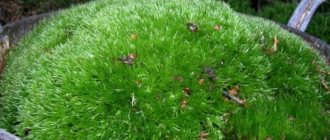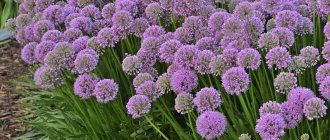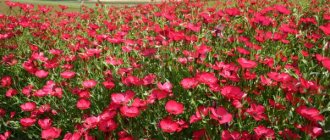Author: Elena N. https://floristics.info/ru/index.php?option=com_contact&view=contact&id=19 Category: Garden plants Published: June 21, 2018Last edits: November 04, 2020
- Watering, fertilizing and replanting
- Pennisetum alopecuroides
Pennisetum grass or pinnately bristleweed (lat. Pennisetum) is a perennial of the Poaceae family. There are from 130 to 150 species in this genus, growing mainly in the temperate climate zones of South America and Africa. The name “pennisetum” is derived from two Latin words that translate as “feather” and “bristle”, and describes the appearance of the inflorescences of representatives of the genus. In the gardens of the middle zone, the pennisetum plant is still an infrequent visitor, since it does not have the cold resistance necessary to survive in our climate. However, the attractiveness of pennisetum contributes to the growth of its popularity among designers and gardeners.
Planting and caring for pennisetum
- Flowering: from July to September.
- Planting: annual species can be sown directly into the ground in the first ten days of May, and seeds are sown for seedlings in mid-April. Annual seedlings are planted in open ground at the end of May. Perennial species, if you want to see them bloom already this year, are sown for seedlings in the second half of February, and seedlings are planted in the garden at the end of May.
- Lighting: bright sunlight.
- Soil: fertile, rich in humus, moist, slightly acidic.
- Watering: only required during periods of prolonged drought.
- Feeding: when grown in poor soil - once a month with a solution of complex mineral fertilizer.
- Reproduction: by seeds and dividing the bush.
- Pests and diseases: the plant is extremely resistant.
Read more about growing pennisetum below.
Growing pennisetum from seeds When to plant
Pennisetum pinnasetum seeds photo
Sowing in open ground
Seeds can be sown in open ground in the spring with the establishment of real warmth, when the threat of return frosts has passed (around May).
Dig up the area and level it. Scatter the seeds over the surface - they are very small, you don’t need to dig deep into the soil, just cover them with a rake. Moisten the bed without stagnant water. Thin out the shoots that appear soon, leaving a distance of about 80 cm between individual bushes.
Under favorable conditions, self-seeding is possible. It is advisable to plant the plant along fences, fences, and buildings. To get flowering early, you should grow seedlings of pinnate bristle.
Growing seedlings of cirrus bristle
Pennisetum growing from seeds photo seedlings
We do not recommend purchasing seedlings in containers - in most cases they do not take root well. It is not difficult to grow it yourself.
- Start sowing cirrus bristle in late February-early March.
- You will need loose, nutritious soil: you can use universal soil for seedlings.
- It is better to grow immediately in individual containers, since during transplantation the root system should not be exposed. Peat or plastic cups are ideal - later transfer them along with the earthen lump.
- Place 1-2 seeds in one container, lightly pressing them into the soil.
- Spray with a fine spray, cover the crops with cling film, transparent oilcloth or glass.
- Sprout at normal room temperature, provide bright, indirect lighting.
- Expect seedlings to appear in 7-10 days.
- Ventilate the greenhouse and maintain moderate soil moisture. Then remove the cover.
- Young sprouts will require additional lighting and moderate watering, keeping the temperature within 20-22°C.
Transplant into open ground in May. The height of the plant will be 10-15 cm.
Botanical description
Forming dense turf, pennisetums can reach a height of 15 to 130 cm. Their linear leaves are up to half a meter long and up to 5 mm wide, bright green in spring and summer and yellow in autumn, collected at the base. On straight bare stems, rough and covered with bristles only in the lower part, lush cylindrical or almost one-sided spike-shaped panicles of white, burgundy, greenish or pink color, from 3 to 35 cm long, are formed. The many fluffy bristles make the inflorescences attractive. Flowers in pennisetum spikes are of two types: underdeveloped staminate and lush bisexual. The shape of the pennisetum bush resembles a fountain, which is why it is often called fountain grass.
What is a mogar plant?
This is an annual herbal plant that reaches an average height of 60 - 150 cm. The seeds are convex oval or elliptical in shape, light yellow, brown, rusty or black. Stems are erect.
Leaves are 20 - 40 cm long and 1.5 - 3 cm wide, lanceolate in shape. The leaf blade is dense. Spikelets are elliptical, ovoid or spherical, 2 - 3 mm. Flowering season August – October.
Traditional Use:
- The grains are used as an astringent and emollient to treat diarrhea.
- The seeds enhance potency, treat indigestion, and help with fever and cholera.
- Decoction and oil from grains is a good tonic.
- In India, the decoction is used topically on the sites of bone fractures.
- External application of the paste helps treat swelling.
- A decoction made from the plant itself is effective for rheumatism to reduce pain.
- The seeds are suitable for treating diabetes.
- When combined with cow's curd, the grain is effective in treating measles.
- A decoction of the mogar plant and acacia Modest bark is used as a tonic or to increase fertility in women and men.
- Used in combination with other herbs to treat dysuria.
- The plant is considered as a cure for bloating.
Planting pennisetum in open ground
When to plant
Most often, pennisetum is propagated generatively: the seeds of annual pennisetum are sown in boxes or pots in mid-April, and the seedlings grown from them are transplanted into open ground at the end of May. You can sow annual species directly into the ground in the first ten days of May.
In the photo: Growing pennisetum in the garden
Perennial species can also be grown by seed, and if you want to see them bloom this year, you need to sow seeds for seedlings in the second half of February in peat pots: this crop does not tolerate exposure of roots, so it is better to use peat containers for growing seedlings, in which the seedlings are then planted in the flower garden.
- Planting flowers in autumn
How to plant
Pennisetum seeds are pressed several millimeters into the surface of a well-moistened seedling substrate, after which the crops are sprayed with a sprayer and placed in a warm, bright place. The seedlings will begin to appear in a week, and you will need to organize artificial lighting for them, because in February the days are very short, and the seedlings will need good lighting. Seedlings are planted in open ground at the end of May, when they reach a height of 10-15 cm.
Pennisetum prefers open sunny areas with fertile, humus-rich, moist, slightly acidic soils. Pennisetum will not grow well in dry, too dense or sandy soil.
When planting, seedlings are placed at a distance of 60-80 cm from each other at the same depth in which they grew in the seedling container. Keep in mind that pinnasetums can grow strongly and take over territories not intended for them, so it is better to limit the area by digging old slate or metal sheets around the perimeter to a depth of at least 50 cm. And do not forget that pennisetums reproduce by self-seeding.
Growing pennisetum from seeds
Pennisetum seeds
In mid-latitudes, pennisetum is usually grown from seeds that are sown as seedlings. Even beginners in terms of floriculture can cope with this task, since the plant is distinguished by its unpretentiousness and good survival rate. But this applies only to the seedlings themselves, since purchased ready-made specimens often die.
Sowing time
If you plan to cultivate the plant as an annual, then it can be planted immediately in open ground, when the soil is warmed up and the threat of serious frost has passed. Seeds are planted for seedlings in mid-to-late April, using boxes or pots with a specially prepared substrate.
The perennial pennisetum also reproduces by seeds. In order for it to please with its flowering in the year of planting, seedlings must be sown in mid-February. It is best to grow young seedlings in peat pots so that the root system is not exposed during transplantation.
Pennisetum, growing from seeds
Growing seedlings
- Soil for pennisetum can be purchased at the store. The main condition is that it must “breathe”. Landing rules:
- Moisten the soil.
- Distribute the seeds on its surface, embedding them to a depth of no more than 4 mm.
- Spray with warm water.
- Place the seed pots in a warm place with enough light.
- After 7-10 days, the first shoots should appear.
- Watering seedlings is carried out in the same way as moistening any similar seedlings. The main rule is not to flood the soil and prevent it from drying out.
- Since sunny days are still short in February and early May, additional lighting will have to be provided for the plants. Otherwise, the seedlings will be fragile, pale and sickly.
Attention. There is no need to cover crops with film; seed germination is quite high, so the plant does not need the greenhouse effect
Caring for pennisetum in the garden
Watering, fertilizing and replanting
Growing pennisetum requires regular weeding and loosening of the soil around the bush. Pennisetum is watered only during periods of prolonged drought. If it grows in poor soil, it is fed once a month with a liquid mineral complex. When grown in fertile soil, the plant does not need fertilizing.
Another representative of cereals is sheep
Pennisetum is afraid of drafts, so it is grown near the walls of buildings that protect it from the wind. Pennisetum does not like to have its roots disturbed, but if you have to replant the plant, you can combine this process with propagation so as not to disturb the root system of Pennisetum twice.
In the photo: Pennisetum bush on the site
Reproduction
As you can see, planting pennisetum and caring for it does not contain any difficulties. There is nothing complicated in dividing the bush, which is used for propagating varietal perennial pennisetums, since seed propagation preserves only the species characteristics of the parents. Bushes are divided in the spring, no more than once every five years. Over time, the central part of the pennisetum begins to deteriorate, so after digging up the bush, it is cut out and destroyed, and the outer areas are divided into large parts, planted in prepared holes and watered.
- How to care for irises in the open ground
Pennisetum in winter
If you are growing a perennial cold-resistant pennisetum, do not cut off its above-ground part for the winter: it will serve as a shelter for the roots of the plant. It is better to cover the root area with a thick layer of fallen leaves or spruce branches. In spring, the cover is removed, and last year's leaves and stems are cut off.
How to care for cirrus bristle
Pennisetum orientalis, growing from seeds, planting and care
Weed young plants to remove weeds and loosen the soil regularly.
Prolonged drought is contraindicated for the grain; it categorically does not tolerate waterlogging of the soil. Focus on precipitation. Water regularly and sparingly, keeping the soil slightly moist.
In the summer, fertilize monthly. Complex mineral fertilizers and organic matter are suitable.
Types and varieties
Pennisetum alopecuroides
A perennial plant native to Australia and East Asia, its inflorescences remain decorative even in winter. Pennisetum foxtail forms a wide bush with a height of 40 to 100 cm. It has narrow leaves, green in the warm season and golden yellow in autumn and winter. Light brown or reddish-brown, brush-like spikes form at the ends of arched or straight stems. This species is characterized by relative winter hardiness and tolerates frosts down to -5 ºC, so in regions with warm winters it is grown in a perennial crop, not forgetting to protect the root zone from frost. Popular varieties of the species are:
- Pennisetum Hameln is the shortest variety of this species, blooming in the year of planting towards the end of summer;
- pennisetum Red Head is a relatively new variety with spectacular smoky purple-red inflorescences, most decorative in winter against the backdrop of snow.
In the photo: Pennisetum alopecuroides
Pennisetum orientale
In nature, it grows on rocks, pebbles, and screes in the tropics and subtropics of Central and Western Asia, Transcaucasia, India, Pakistan and Northeast Africa. This is a perennial plant that forms turfs with a height of 15 to 80 cm. The leaves of Pennisetum orientalis are up to 4 mm wide, most often folded lengthwise. Dense one-sided spike-shaped panicles from 4 to 15 cm long are colored pinkish-violet and covered with rough bristles up to 27 mm long. In the middle zone, this species is grown as an annual crop due to its low cold resistance.
In the photo: Pennisetum orientale
Pennisetum villosum
It occurs naturally on rocks and screes in East Africa, where it grows as a perennial. This species reaches a height of 30 to 60 cm. It has flat leaves up to 5 mm wide and golden short-cylindrical or ovoid spike-shaped panicles from 3 to 10 cm long, pubescent with pinnately hairy bristles up to 5 cm long. In the middle zone this plant is grown like an annual. Its inflorescences seem to be created for dry bouquets.
In the photo: Pennisetum villosum
Pennisetum incomptum
An aggressive long-rhizome plant native to China. It reaches a height of 120 cm, its leaves are green or green with a gray tint, flowering occurs from June to September: at first the flowers are greenish, then they lighten, and over time they become yellow-brown. The ears of Pennisetum simplex are not as spectacular as those of other species, but it is valued not for its decorativeness, but for its early flowering and cold resistance: Pennisetum simplex is able to withstand cold temperatures down to -29 ºC, although there were cases when it tolerated stronger frosts well.
Pennisetum setaceum
In nature it grows on stones and screes of Arabia, as well as in the tropics and subtropics of Northeast Africa. This is a heat-loving perennial, grown in our culture as an annual plant. The height of pennisetum bristles reaches from 70 to 130 cm. Its leaves are usually flat, up to 6 mm wide; Spike-shaped, one-sided, loose, drooping panicles from 15 to 35 cm long are colored purple or pink. Flowering begins in the second half of summer. The most famous variety of the species:
- Bergenia: planting and care in the garden, types and varieties
- Rubrum is a plant with drooping panicles of pink or dark red color, covered with feathery-hairy bristles up to 4 cm long.
In the photo: Pennisetum setaceum
Pennisetum glaucum
A very beautiful dense bush plant up to 2 m high with bronzed-burgundy leaves up to 35 mm wide. The following varieties of this species are especially popular:
- Purple Majesty is a very showy plant, up to 150 cm high, which received an AAS gold medal: when young the leaves are green, but gradually under the sun the leaves, stem and inflorescences become dark purple, almost black;
- Pennisetum Purple Baron (or Fantastic Foliage, as this variety is called in the West) is a dense, compact bush, green when young, but gradually acquiring an even darker and more saturated color than that of Purple Majesty. The leaves of the Purple Baron are shorter and wider than those of the variety described above;
- Pennisetum Jade Princess (Jade Princess) is a plant up to 1 m high with lemon-green leaves and spectacular shaggy red-burgundy inflorescences.
In the photo: Pennisetum glaucum
Types of ornamental grass Pennisetum
Only a few of the 150 known species grow in our climate. But they also differ in diversity in plant height, color and other characteristics. The most popular in landscape design are:
Pennisetum alopecuroides
A perennial plant 0.4-1 m tall. The leaf blade is linear and has an emerald hue, which becomes sunny yellow in autumn. Dense red-cherry spikelets grow on an arched stem.
Foxtail pinnately bristle
Blooms later - from August to September. Its advantage for our latitudes is frost resistance. The most famous variety of this species is the low-growing pennisetum hameln.
Pennisetum setaceum
Also a perennial species. Its height varies between 07-1.3 m. It has narrow leaves and pink-purple loose spikelets. Blooms late - mostly pleasing in early autumn. This is a fairly heat-loving species. In particularly cool regions it is grown as an annual. The Rubrum variety is famous for its burgundy inflorescences.
Gray pinnately bristleweed or pearl millet (lat. Pennisetum glaucum)
Gray pinnately bristleweed (lat. Pennisetum glaucum)
Tall grass - up to 2 m with wide burgundy-bronze foliage - up to 3.5 cm. Blooms from July until the end of September. Northern regions use the species as an annual plant in garden landscaping.
Among ornamental varieties, pennisetum purple baron and purple maestro have gained popularity.
Pennisetum incomptum
The long rhizome prevents this perennial from freezing even at -29°C. The height of the plant reaches 1.2 m. Its advantage is also its early flowering - from the end of June, which continues until autumn. Over time, green spikelets acquire a rich yellow and even brownish tint.
Pennisetum simple will decorate any flower bed
Hairy cirrus bristleweed (Pennisetum Villosum)
Low-growing bush 0.3-0.6 m, perennial. The narrow leaves are less than half a centimeter wide. Golden spikelets with fibers bloom in August.
The hairy pinnate bristle attracts the eye with its fluffy spikelets.
Pennisetum orientale
In nature, it grows on rocky terrain, reaches a height of 0.15 to 0.8 m. Green foliage 1-4 mm wide frames pink and purple panicles.
Oriental pinnate bristle is also in demand among our gardeners.
The diversity of the plant makes it easy to select the desired configuration for a specific area and advantageously present the entire composition.
Pennisetum in landscape design
Pennisetum, like other ornamental grasses, is actively used in landscaping and landscape design, not only in landscape style, but also in row planting. To create a landscape composition, pennisetum foxtail is planted more often than other species as a large plant accent. In aquatic compositions, low-growing marigold and kotula crops look good against its background.
In row planting, pinnate bristle is used to create a border. Framing paths, pennisetum emphasizes the decorative nature of plants located in a flower garden or on a lawn.
With the help of pennisetum, you can create rocky compositions that look natural and at the same time decorative, and in which the leaves of pennisetum create the effect of a bright spot. In combination with pennisetum in such compositions, you can grow crops typical of mountain landscapes: lavender, young, stone rose, Byzantine chistets or gray fescue.
Pennisetum is also used in mixborders, in compositions of continuous flowering, since it gives a high decorative effect that changes over time. Pennisetum also looks great in mono-compositions: you can create a flower garden in one area from different varieties and species of this plant, differing in the color of the leaves and inflorescences.
Diseases and pests
As a rule, Cirrus is slightly vulnerable to disease. In ideal conditions, they grow very well and delight owners with their beauty. The only risk is rot, which can also manifest itself as so-called “rust”. Long-term treatment is a replacement of the soil, since rot can only develop in constantly moist conditions. When replacing the soil, you should ensure that all affected parts are removed and replaced with loose soil.
Tip: Pennisetum should not be pruned in the fall to avoid rotting.
Spider mites can be an unpleasant surprise. Chemicals can be used in emergency situations. Alternatively, spraying water on the plants may be sufficient. To wash away these little pests.
Otherwise, the Cirrus is very resistant to pests.
Pennisetum shelter for the winter
The culture is thermophilic, but many representatives are adapted to temperate climate conditions. Some species are cultivated as annuals; they can also be grown in flowerpots and brought indoors for wintering. Frost-resistant species successfully winter in open ground. With the onset of autumn, you should collect the stems in bunches, tie them, and cover them with spruce branches.
In the spring, prune so that the plant awakens and begins to grow. Another shelter option: cut the stems at the root in the fall, mulch with dry bark, peat or fallen leaves. You can also transplant it into a pot and store it indoors until spring.
If the winters in your region are harsh, the bush will decrease in size every year. After 2-3 years it will need to be replaced with a new one.











